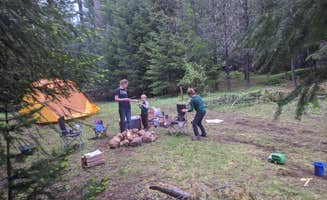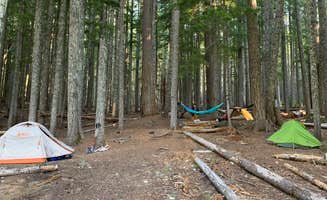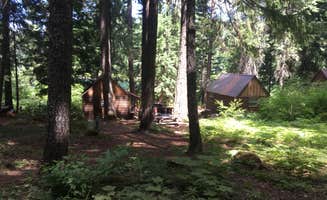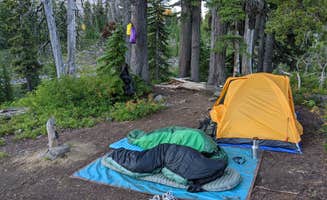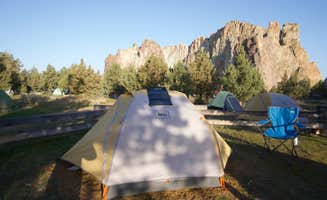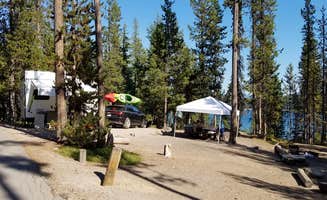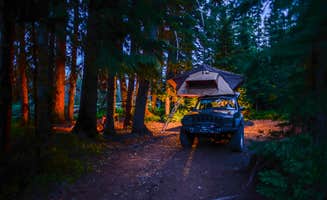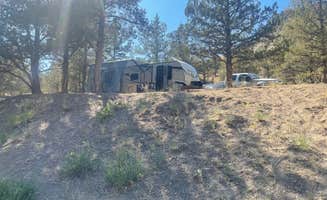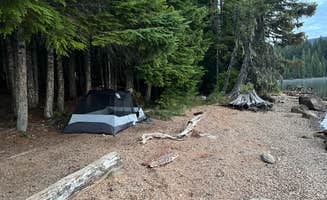Dispersed camping areas near Camp Sherman, Oregon sit at elevations between 3,000 and 4,500 feet within the eastern Cascade range. Summer temperatures typically reach 75-85°F during day and drop to 40-50°F at night. Many sites require high-clearance vehicles to access forest roads that branch from Highway 20 and Highway 22, with conditions varying significantly after winter snowmelt.
What to do
Swimming at natural waterfalls: Visit Steelhead Falls Trailhead & Campground where a half-mile hike leads to swimming holes. "Half a mile to see the steelhead waterfall" with spots where "you can fish and jump off the rocks into the water," according to visitors who enjoy the cooling waters during hot summer months.
Fishing for trout: Bring fishing gear when tent camping near Camp Sherman as multiple waterways offer angling opportunities. The Deschutes River canyon provides excellent fishing spots near Steelhead Falls, while other nearby lakes stock rainbow and cutthroat trout. A visitor to Round Lake noted it has "great fishing for Rainbows and Cutthroat trout" with "the lake itself shallow till about 50 feet out where its a straight drop to a black abyss."
Mountain hiking with permits: Access Pamelia Lake for backcountry hiking with proper permits (secured through lottery). "We summited Grizzly Peak and saw beautiful views of Mount Jefferson," reports one camper who used this as base camp. Sites are "very spacious, we could have easily fit 8 people at our site" for groups wanting to explore together.
What campers like
Spacious sites with privacy: Campers appreciate the generous spacing at most tent sites. At Round Lake, visitors find "multiple dispersed sites with fire rings and picnic tables" though some note "not much shade at sites, can be dusty." The lake itself compensates for these drawbacks as it's "great for swimming and floating" during hot weather.
Night sky viewing: The lack of light pollution makes stargazing exceptional in the Camp Sherman region. Marion Forks Campground visitors report taking "my chair down beside the hatchery and just watch the stars. Magical" during summer evenings when skies remain clear and temperatures cool to comfortable levels for extended outdoor time.
Educational opportunities: The Marion Forks Campground provides learning experiences with its adjacent fish hatchery. "My boys and now my granddaughter love going to the the fish hatchery and seeing the baby fish and the HUGE fish," making this location particularly appealing for families with younger children who want nature-based educational activities.
What you should know
Limited water access: Most dispersed camping areas require bringing your own water or filtering from streams. Near FS Rd 1514 Dispersed camping, there are no designated water sources and "in early May we had it to ourselves" but come prepared with adequate water supplies regardless of season.
Fire restriction variability: Fire rules change frequently based on conditions. During summer months (June-September), most areas implement restrictions. A camper notes that at Steelhead Falls, "When we went, fires were allowed, and there was a residence on the road in (clearly marked) selling firewood. And they took Venmo!"
Mosquito preparation: Bugs can be problematic, especially in early summer. Maxwell Sno-Park visitors report "in mid-June there were a lot of mosquitoes about" while another camper mentioned being "buggy. Skeeters and some hornets but not bad." Pack appropriate repellent and protective clothing if camping during peak insect season.
Tips for camping with families
Select shorter hiking options: For families with children, choose trails under 2 miles. "The trail by the creek is really nice and the fish hatchery is cool to check out" at Marion Forks, providing engaging activities without overexerting younger hikers. Educational panels along paved pathways make learning accessible.
Look for educational sites: The Marion Forks fish hatchery offers learning opportunities where "sometimes the staff will give you a tour" according to campers. Children can observe different stages of fish development in the pools, with "educational signs, short hikes, and access to water near the campground."
Consider fenced camping areas: At Smith Rock State Park Campground, the bivouac camping area provides defined spaces that some families prefer. "There's nice showers with hot water! The hiking is fantastic" reports one visitor, making this a good option for families wanting more structure and facilities.
Tips from RVers
Length restrictions matter: Check vehicle limitations before arriving at forest service roads. At Steelhead Falls, "There is a sign in the way in indicating 30ft length max, but there is no mention on the BLM site. They must mean trailer length since we had no issues with our 22' trailer and rig (40ft total)."
Limited large rig spots: RVers should arrive early to secure appropriate sites. "There are only 2 spots and the end loop where a trailer will fit, have a backup plan if you have a trailer just in case they are taken" warns a visitor to Steelhead Falls, emphasizing the need for flexibility when bringing larger vehicles.
Consider dust impact: During dry months, dispersed camping with RVs can create dust issues. At Harrington Loop Rd - Dispersed, campers note sites "all appear well taken care of and clean" but "it can get pretty dusty though when the wind picks up," potentially affecting outdoor comfort around vehicles.


